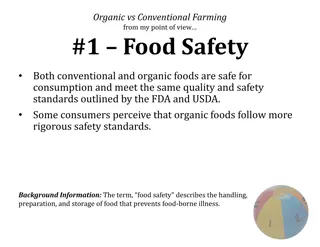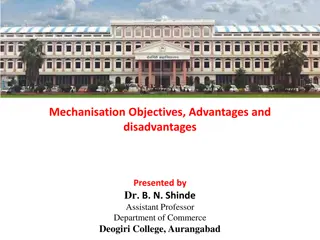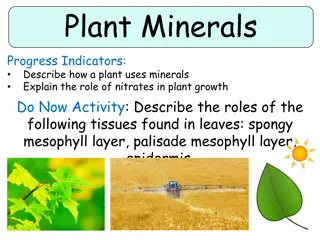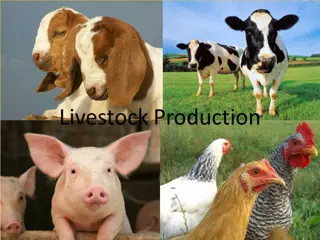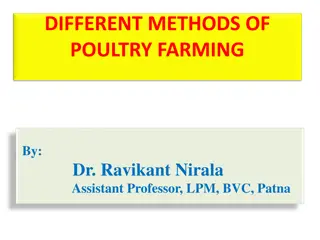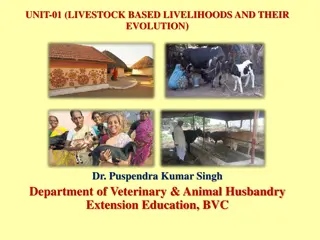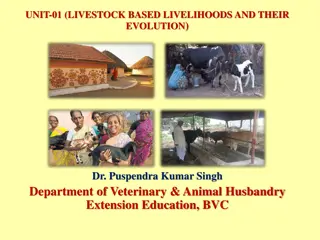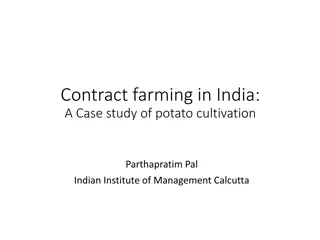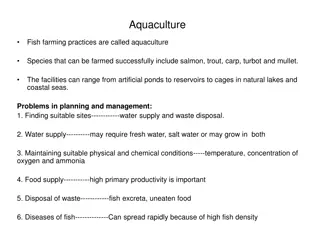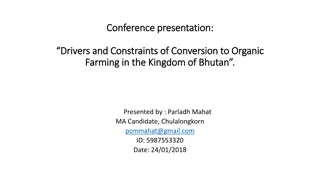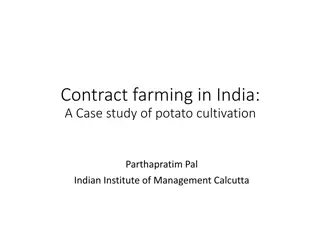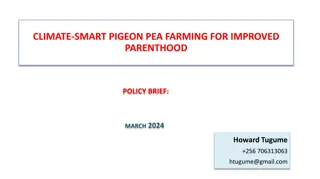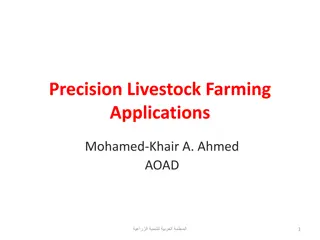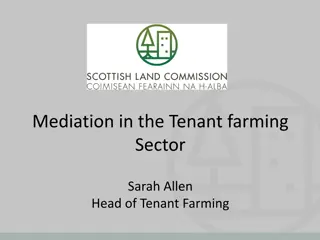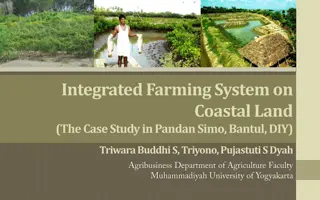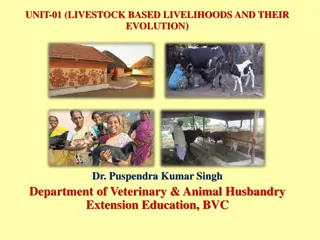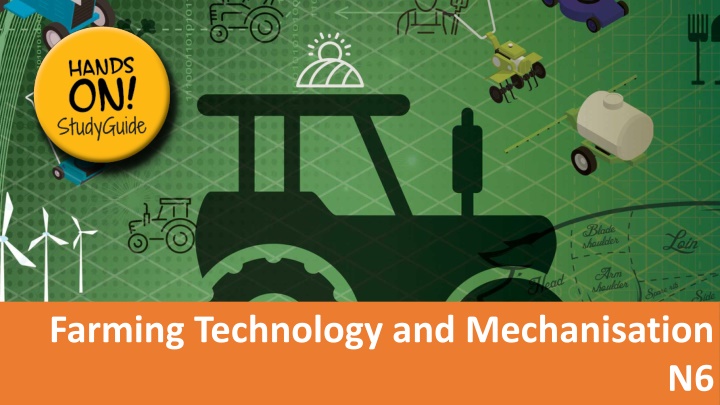
Farm Equipment Maintenance Planning and Safety Precautions
Develop a comprehensive maintenance plan for farm equipment to ensure smooth operations, increase lifespan, reduce downtime, improve efficiency, enhance safety, and save money. Learn about different types of maintenance, such as preventative, predictive, corrective, scheduled, and condition-based, and the importance of maintaining detailed records. Follow safety precautions as required by the Occupational Health and Safety Act to maintain equipment effectively.
Download Presentation

Please find below an Image/Link to download the presentation.
The content on the website is provided AS IS for your information and personal use only. It may not be sold, licensed, or shared on other websites without obtaining consent from the author. If you encounter any issues during the download, it is possible that the publisher has removed the file from their server.
You are allowed to download the files provided on this website for personal or commercial use, subject to the condition that they are used lawfully. All files are the property of their respective owners.
The content on the website is provided AS IS for your information and personal use only. It may not be sold, licensed, or shared on other websites without obtaining consent from the author.
E N D
Presentation Transcript
Module 1 - Maintenance planning and safety precautions on the farm INTRODUCTION The basic principles of maintenance planning on a farm involve developing a comprehensive plan for maintaining all the equipment and infrastructure necessary for the smooth operation of the farm. www.futuremanagers.com
Module 1 - Maintenance planning and safety precautions on the farm (continued) BASIC PRINCIPLES OF MAINTAINANCE PLANNING Conducting regular inspections; Prioritising maintenance tasks; Scheduling maintenance tasks; Ensuring proper training; and Keeping detailed records. www.futuremanagers.com
Module 1 - Maintenance planning and safety precautions on the farm (continued) MAINTAINANCE PLANNING Maintenance planning on the farm for farming equipment and implements is crucial for several reasons: Increases equipment lifespan; Reduces downtime; Improves efficiency; Enhances safety; and Saves money. www.futuremanagers.com
Module 1 - Maintenance planning and safety precautions on the farm (continued) DIFFERENT TYPES OF MAINTENANCE There are several different types of maintenance that can be carried out on farm equipment and machinery, each with its own objectives and benefits: Preventative maintenance; Predictive maintenance; Corrective maintenance; Scheduled maintenance; and Condition-based maintenance. www.futuremanagers.com
Module 1 - Maintenance planning and safety precautions on the farm (continued) DEVELOPING FARM EQUIPMENT MAINTENANCE RECORDS Designing farm equipment maintenance records involves creating a system to track and document maintenance activities for each piece of equipment on the farm. www.futuremanagers.com
Module 1 - Maintenance planning and safety precautions on the farm (continued) SAFETY PRECAUTIONS ON THE FARM The Occupational Health and Safety Act, 1993, requires the employer to bring about and maintain all equipment, as far as reasonably practicable, and a work environment that is safe and without risk to the health of the workers. www.futuremanagers.com
Module 2 - Tractor maintenance INTRODUCTION The term, tractor refers to a vehicle used on farms to: Pull or push agricultural machinery or trailers. Perform ploughing, tilling, disking, harrowing, planting, and similar tasks. Provide a hydraulic power source (PTO) to drive other equipment and implements. Perform landscaping and earth moving tasks. www.futuremanagers.com
Module 2 - Tractor maintenance (continued) CONSTRUCTION OF THE TRACTOR S ENGINE A typical farm tractor is an open vehicle, with two large rear driving wheels. Above the axle is a single seat for the operator. The engine is situated in front of the driver. This basic tractor design has remained unchanged for several years. www.futuremanagers.com
Module 2 - Tractor maintenance (continued) COMPONENTS OF THE TRACTOR www.futuremanagers.com
Module 2 - Tractor maintenance (continued) HYDRAULIC SYSTEM The main purpose of hydraulic systems is to create motion or force. The hydraulic system of a tractor enables the tractor to upload and offload agriculture goods as well as to raise or lower heavy implements as per requirements and to control implement depth during field operations. www.futuremanagers.com
Module 2 - Tractor maintenance (continued) SIMPLE MAINTENANCE OF A TRACTOR The importance of maintenance can never be underestimated. Preventative maintenance is important for all machinery to increase their lifespan. Scheduled maintenance improves safety, reliability, and performance and decrease financial expenses. www.futuremanagers.com .
Module 2 - Tractor maintenance (continued) THE TRACTOR S ELECTRICAL SYSTEM The electrical system provides the electrical energy from the battery to all electrical and electronic components that allow the vehicle to start and operate. The battery is normally 12 volt, or two 12 volt batteries connected in series for 24 volts. The system also powers other main components, such as the ignition, fuel system, drive train, and light system. This electric energy returns to the battery via wiring and earth connections. www.futuremanagers.com
Module 2 - Tractor maintenance (continued) MAINTENANCE OF THE COOLING SYSTEM OF A TRACTOR The cooling system of a tractor comprises of many components that work together to maintain a constant engine temperature. The position of the radiator makes it prone to damage. The radiator is regarded as a consumable component in the cooling system. The cooling system has a direct effect on the longevity of the engine as well as the lubrication. Cooling systems, as lubrication systems, need scheduled maintenance to ensure effective heat and emission control of the internal combustion engine. www.futuremanagers.com
Module 3 Farm implements in operations INTRODUCTION Agricultural land preparation is a process of preparing the soil for planting. This is normally done by ploughing or removing vegetation. Preparing the land means removing unwanted plants, rocks, and other elements. Once removed, the soil will receive minerals and other nutrients. www.futuremanagers.com
Module 3 Farm implements in operations (continued) RISK MANAGEMENT All farms need to manage the risks of injury that are part of farming activities. All agricultural implements and the tools that a farmer uses to prepare the soil or to plant crops, has many hazards that hold a risk of injuring the operator and labourer. www.futuremanagers.com
Module 4 Calibration of farm implements INTRODUCTION Calibration is the checking, evaluating, or setting a machines application rate and patterns of dispersal. www.futuremanagers.com
Module 4 Calibration of farm implements (continued) THE NEED FOR EVALUATING THE PERFORMANCE OF MACHINES The farmer needs agricultural machinery to assist with the dispensing of materials as: Seeds; Fertilisers; and Sprays (pesticides and herbicides). www.futuremanagers.com
Module 4 Calibration of farm implements (continued) THE PRINCIPLES OF CALIBRATION It would be almost impossible for a dispensing machine to distribute the precise amount of material. Perfection is not always expected. Therefore, levels of acceptability must be established. The amount of error that would be considered acceptable varies for each machine and situation. www.futuremanagers.com
Module 4 Calibration of farm implements (continued) TWO CALIBRATION METHODS The stationary method: The wheel that drives the machine metering unit must be above ground level so it does not contact the surface, thereafter it is turned for a fixed number of revolutions. The mobile calibration method: The flow of material is diverted into a container as the machine is pulled or driven through the field. www.futuremanagers.com
Module 4 Calibration of farm implements (continued) BE ABLE TO CALIBRATE BROADCAST TYPE FERTILISER APPLICATORS Fertilisers, which are mainstays of modern agriculture, are applied in: Liquid (follows the same principles as spraying chemicals and sprayers), Gaseous, or Granular form. www.futuremanagers.com
Module 4 Calibration of farm implements (continued) BE ABLE TO CALIBRATE A FIELD SPRAYER The accurate calibration of spray equipment is very important because with only slight changes the application rate may: Cause chemical damage to the crop or the environment, Be wasteful of materials, or Be ineffective. www.futuremanagers.com
Module 4 Calibration of farm implements (continued) BE ABLE TO PREPARE THE CORRECT MIX A very important part of chemical application is the correct preparation and mixing of the chemical and the carrier (usually water). The application rates of most chemicals are given in terms of kilograms (or liter) of active ingredient to be applied per hectare. The concentration for a liquid chemical is usually printed on the label. A typical material might contain 0,5 kg of active ingredient per litre. www.futuremanagers.com
Module 4 Calibration of farm implements (continued) THE IMPORTANCE OF CALIBRATING FARM EQUIPMENT Some of the key benefits of calibrating your agricultural machinery include: Improved accuracy; Reduced costs; Extended machine life; Improved quality; and It is greener. www.futuremanagers.com
Module 5 Fence installations and maintenance INTRODUCTION Reasons for a fence: Stock management; Land and pasture management; Crop and stock protection; Human safety; Legal requirements; and Aesthetics. www.futuremanagers.com
Module 5 Fence installations and maintenance (continued) FACTORS TO BE CONSIDERED WHEN SELECTING THE TYPE OF AGRICULTURAL FENCE TO USE Factors to consider include: The type of animal being contained or kept out, the terrain and soil conditions, The climate, and The overall purpose of the fence. www.futuremanagers.com
Module 5 Fence installations and maintenance (continued) REQUIREMENTS FOR SUITABLE FENCES AND FENCING Strength and durability; Height and width; Visibility; Maintenance; Legal requirements; Cost-effective; and Compatibility with livestock management, www.futuremanagers.com
Module 5 Fence installations and maintenance (continued) CONSTRUCTION OF CORNER POSTS, STRAINING POSTS, AND GATE POSTS Straining posts and gate posts are critical components of fences, providing the necessary strength and support to ensure that the fence line remains stable and secure. www.futuremanagers.com
Module 5 Fence installations and maintenance (continued) FUNCTION OF TRESTLE ANCHORS AND CORNER POSTS Trestle anchors (also known as anchor posts or straining posts) and corner posts are both important components of agricultural fences, and each serves a distinct function. www.futuremanagers.com


